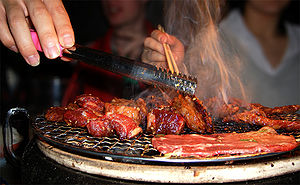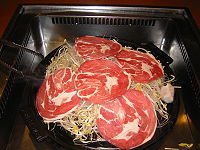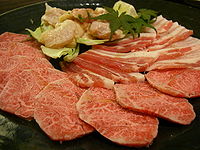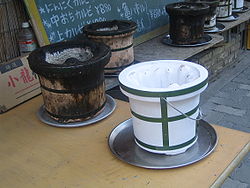
Yakiniku
Encyclopedia

Grill
-In food:* Barbecue grill, a device or surface used for cooking food, usually fuelled by gas or charcoal, or the part of a cooker that performs this function.* Grilling, a form of cooking that involves direct heat....
ed meat
Meat
Meat is animal flesh that is used as food. Most often, this means the skeletal muscle and associated fat and other tissues, but it may also describe other edible tissues such as organs and offal...
", is a Japanese
Japanese language
is a language spoken by over 130 million people in Japan and in Japanese emigrant communities. It is a member of the Japonic language family, which has a number of proposed relationships with other languages, none of which has gained wide acceptance among historical linguists .Japanese is an...
term which, in its broadest sense, refers to grilled meat dishes. The present style of yakiniku restaurants are derived from the Korean restaurants in Osaka and Tokyo which were opened around 1945.
Yakuniku is a variant of bulgogi
Bulgogi
Bulgogi is a Korean dish that usually consists of marinated barbecued beef, although chicken or pork may also be used. It is listed at number 23 on World's 50 most delicious foods readers' poll complied by CNN Go in 2011.-Etymology:...
that has been modified by Zainichi Korean
Zainichi Korean
Koreans in Japan are the ethnic Korean residents of Japan. They currently constitute the second largest ethnic minority group in Japan. The majority of Koreans in Japan are Zainichi Koreans, also often known as Zainichi for short, who are the permanent ethnic Korean residents of Japan...
s to appeal to Japanese tastes.
Today, it commonly refers to a Japan
Japan
Japan is an island nation in East Asia. Located in the Pacific Ocean, it lies to the east of the Sea of Japan, China, North Korea, South Korea and Russia, stretching from the Sea of Okhotsk in the north to the East China Sea and Taiwan in the south...
ese style of cooking bite-sized meat (usually beef
Beef
Beef is the culinary name for meat from bovines, especially domestic cattle. Beef can be harvested from cows, bulls, heifers or steers. It is one of the principal meats used in the cuisine of the Middle East , Australia, Argentina, Brazil, Europe and the United States, and is also important in...
and offal
Offal
Offal , also called, especially in the United States, variety meats or organ meats, refers to the internal organs and entrails of a butchered animal. The word does not refer to a particular list of edible organs, which varies by culture and region, but includes most internal organs other than...
) and vegetables on gridiron
Gridiron (cooking)
A gridiron is a metal grate with parallel bars typically used for grilling meat, fish, vegetables, or combinations of such foods. It may also be two such grids, hinged to fold together, to securely hold food while grilling over an open flame.-Development:...
s or griddle
Griddle
A griddle is a cooking device consisting of a broad flat surface that can be heated using a variety of means, and is used in both residential and commercial applications for a variety of cooking operations. Most commonly, the griddle consists of a flat metal plate, but in the non-industrialized...
s over flame of wood charcoals carbonized by dry distillation
Dry distillation
Dry distillation is the heating of solid materials to produce gaseous products . The method may or may not involve pyrolysis/thermolysis. The products are condensed and collected. This method usually requires higher temperatures than classical distillation. The method has been used to obtain...
(sumibi, 炭火) or gas/electric grill. In North America, mainland China and Taiwan, Yakiniku is also referred to as "Japanese barbecue" while in Japan the origin has become a subject of debate, though it is conventionally considered to be Korean cuisine. In 2002 the NHK
NHK
NHK is Japan's national public broadcasting organization. NHK, which has always identified itself to its audiences by the English pronunciation of its initials, is a publicly owned corporation funded by viewers' payments of a television license fee....
program NHK Ningen Kouza (NHK人間講座, literally NHK Humanity lecture) stated: "While some tend to think that yakiniku came from Korea, it was born in post war Japan." Yet there are those who say that while yakiniku may have its beginnings in Japan, they believe it was first made by Korean Zainichi and should therefore be considered Korean cuisine.
In a yakiniku restaurant, diners order several types of prepared raw ingredients (either individually or as a set) which are brought to the table. The ingredients are cooked by the diners on a grill built into the table throughout the duration of the meal, several pieces at a time. The ingredients are then dipped in sauces known as tare
Tare sauce
Tare is a general term in Japanese cuisine for dipping sauces often used in grilling as well as with sushi, nabemono and gyoza. The sauce is best described as sweetened, thickened soy sauce for grilling and flavored soy sauce with dashi, vinegar, etc., for nabemono and natto such as ponzu but...
before being eaten. The most common sauce is made of Japanese soy sauce mixed with sake, mirin
Mirin
is an essential condiment used in Japanese cuisine, consisting of 40%–50% sugar. It is a kind of rice wine similar to sake, but with a lower alcohol content—14% instead of 20%. There are three general types. The first is hon mirin , which contains alcohol. The second is shio mirin, which contains...
, sugar, garlic, fruit juice and sesame. Garlic
Garlic
Allium sativum, commonly known as garlic, is a species in the onion genus, Allium. Its close relatives include the onion, shallot, leek, chive, and rakkyo. Dating back over 6,000 years, garlic is native to central Asia, and has long been a staple in the Mediterranean region, as well as a frequent...
-and-shallot
Shallot
The shallot is the botanical variety of Allium cepa to which the multiplier onion also belongs. It was formerly classified as the species A. ascalonicum, a name now considered a synonym of the correct name...
or miso
Miso
is a traditional Japanese seasoning produced by fermenting rice, barley and/or soybeans, with salt and the fungus , the most typical miso being made with soy. The result is a thick paste used for sauces and spreads, pickling vegetables or meats, and mixing with dashi soup stock to serve as miso...
-based dips are sometimes used.
Etymology



Meiji Restoration
The , also known as the Meiji Ishin, Revolution, Reform or Renewal, was a chain of events that restored imperial rule to Japan in 1868...
as part of an effort to introduce western culture to the country. The Emperor Meiji
Emperor Meiji
The or was the 122nd emperor of Japan according to the traditional order of succession, reigning from 3 February 1867 until his death...
became part of a campaign to promote beef consumption, publicly eating beef on January 24, 1873. Steak and roasted meat were translated as yakiniku (焼肉) and iriniku (焙肉), respectively, as proposed western-style menus in Seiyō Ryōri Shinan published in 1872, although this usage of the former word was eventually replaced by the loanword sutēki.
Jingisukan
Jingisukan
is a Japanese grilled mutton dish prepared on a convex metal skillet or other grill. The dish is particularly popular on the northern island of Hokkaidō and Thailand.-Etymology:...
(ja:ジンギスカン, the Japanese transliteration of Genghis Khan
Genghis Khan
Genghis Khan , born Temujin and occasionally known by his temple name Taizu , was the founder and Great Khan of the Mongol Empire, which became the largest contiguous empire in history after his death....
), is a style of grilling mutton, which is also referred to as a type of yakiniku. The dish was conceived in Hokkaidō, where it has ever since been a popular blue-collar dish, but has only recently gained nationwide popularity. The name Jingisukan is thought to have been invented by Sapporo-born Tokuzo Komai, who was inspired by grilled mutton dishes in Manchuria
Manchuria
Manchuria is a historical name given to a large geographic region in northeast Asia. Depending on the definition of its extent, Manchuria usually falls entirely within the People's Republic of China, or is sometimes divided between China and Russia. The region is commonly referred to as Northeast...
. The first written mention of the dish under this name was in 1931.
Ventilated barbecue systems, introduced by Shinpo Co., Ltd. in March 1980, quickly spread throughout Japan as it enabled diners to eat Yakiniku in a smoke-free environment and thus greatly extended the clientele.
The popularity of yakiniku was given a further boost in 1991 when the easing of beef import restrictions led to a drop in the price of beef. However the industry was dealt an unprecedented blow in 2001 with the occurrence of BSE
Bovine spongiform encephalopathy
Bovine spongiform encephalopathy , commonly known as mad-cow disease, is a fatal neurodegenerative disease in cattle that causes a spongy degeneration in the brain and spinal cord. BSE has a long incubation period, about 30 months to 8 years, usually affecting adult cattle at a peak age onset of...
(mad cow disease) within Japan.
Typical ingredients

- Beef and pork
- Rōsu - loin and chuck slices
- Karubi or baraniku - short ribs. From the Korean word "galbiGalbiGalbi or kalbi generally refers to a variety of gui or grilled dishes in Korean cuisine that is made with marinated beef short ribs in a ganjang-based sauce . In the Korean language, galbi literally means "rib" and can often indicate uncooked ribs...
". In Japan it is usually served without the bones, unless it is specified as hone-tsuki-karubi. - Butabara - pork belly.
- Horumon or motsu - Offal.
- Harami - tender meat around the diaphragm.
- Rebā - beef liverLiverThe liver is a vital organ present in vertebrates and some other animals. It has a wide range of functions, including detoxification, protein synthesis, and production of biochemicals necessary for digestion...
. From the German word "Leber". - Tan - beef tongueTongueThe tongue is a muscular hydrostat on the floors of the mouths of most vertebrates which manipulates food for mastication. It is the primary organ of taste , as much of the upper surface of the tongue is covered in papillae and taste buds. It is sensitive and kept moist by saliva, and is richly...
. From the English word "tongue". Often served with salt and lemon juice.. - Tetchan - intestineIntestineIn human anatomy, the intestine is the segment of the alimentary canal extending from the pyloric sphincter of the stomach to the anus and, in humans and other mammals, consists of two segments, the small intestine and the large intestine...
. From the Chinese word "大肠" (da chang). May simply be referred to as horumon. - Hāto - heartHeartThe heart is a myogenic muscular organ found in all animals with a circulatory system , that is responsible for pumping blood throughout the blood vessels by repeated, rhythmic contractions...
. From the English word "heart". - Kobukuro - Pork uterus. Enjoyed for its gristly texture.
- Tēru - From the English word "tail". Slices of beef tail cut crosswise, bone attached.
- Mino / Hachinosu - beef tripeTripeTripe is a type of edible offal from the stomachs of various farm animals.-Beef tripe:...
- Chicken
- Seafood - squid, shellfish
- Vegetables - bell pepper, carrots, shiitakeShiitakeThe Shiitake is an edible mushroom native to East Asia, which is cultivated and consumed in many Asian countries, as well as being dried and exported to many countries around the world. It is a feature of many Asian cuisines including Vietnamese, Chinese, Japanese, Korean and Thai...
and other mushrooms, onions, cabbage, eggplant, bean sproutMoyashior is Japanese for "sprout." It is most commonly used in referring to mung bean or black matpe bean, but can also be used for the larger soybean sprout as well.Moyashi is a common ingredient in many Japanese dishes such as stir fries and soups....
, garlic, and kabochaKabochaKabocha is a Japanese variety of winter squash. The word kabocha has come to mean a general type of winter squash to many English-speaking growers and buyers. In some cultures it is revered as an aphrodisiac....
squash are common
Yakiniku Day
In 1993, the All Japan Yakiniku AssociationAll Japan Yakiniku Association
The All Japan Yakiniku Association is a Japanese nationwide professional organisation promoting the eating of yakiniku. They are responsible for establishing the "Yakiniku Day" on 29 August.-External links:...
proclaimed 29 August as official "Yakiniku Day" (yakiniku no hi).
See also
- YakitoriYakitori, grilled chicken, is commonly a Japanese type of skewered chicken. The term Yakitori can also refer to skewered food in general. Kushiyaki , is a formal term that encompasses both poultry and non-poultry items, skewered and grilled...
- TeriyakiTeriyakiTeriyaki is a cooking technique used in Japanese cuisine in which foods are broiled or grilled in a sweet soy sauce marinade...
- TeppanyakiTeppanyakiis a style of Japanese cuisine that uses an iron griddle to cook food. The word teppanyaki is derived from teppan , which means iron plate, and yaki , which means grilled, broiled or pan-fried...
- ShichirinShichirin]The shichirin is a small charcoal grill.-Description:The shichirin is a lightweight, compact, and easy-to-move cooking stove. Charcoal is chiefly used for the fuel of shichirin. It has had prototypes since ancient times, and it is said that shichirin roughly the same as today's were made in the...
- YakisobaYakisoba', literally "fried noodles", is a dish often sold at festivals in Japan, but originates in China. The dish was derived by the Chinese from the traditional chow mein, but has been more heavily integrated into Japanese cuisine like ramen...
- GalbiGalbiGalbi or kalbi generally refers to a variety of gui or grilled dishes in Korean cuisine that is made with marinated beef short ribs in a ganjang-based sauce . In the Korean language, galbi literally means "rib" and can often indicate uncooked ribs...
- BulgogiBulgogiBulgogi is a Korean dish that usually consists of marinated barbecued beef, although chicken or pork may also be used. It is listed at number 23 on World's 50 most delicious foods readers' poll complied by CNN Go in 2011.-Etymology:...
- Gyu-KakuGyu-Kakuis a chain of Japanese yakiniku restaurants specializing in barbecued beef.Gyu-Kaku is known for its unique form of dining in which the customers are involved in the cooking process of grilling their own food. Each table has a charcoal brazier built in and is equipped with tongs for cooking....
, a chain of yakiniku restaurants - Cuisine of Japan
- Korean barbecueKorean barbecueKorean barbecue, or gogi gui literally "meat + roasted meat", refers to the Korean method of grilling beef, pork, chicken, or other types of meat. Such dishes are often prepared at the diner's table on gas or charcoal grills that are built into the center of the table itself...
External links
- Yakiniku Web, the official site of the All Japan Yakiniku Association (in Japanese)
- 'Life picture of east Asia' 2008-2 Kanagawa University (in Japanese), p. 112

